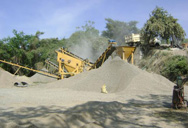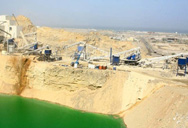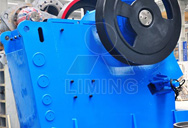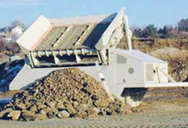


influence of manufactured sand on high strength concrete ppt. Influence of manufactured sand characteristics on strength and abrasion resistance of pavement concrete, Construction and Building materials, 25, 2011, pp. 38493853. [6] Prakash Nanthagopalan, Manu Santhanam
Read More
2009-7-9 Wang, J., Yang, Z., Niu, K. et al. Influence of MB-value of manufactured sand on the shrinkage and cracking of high strength concrete. J. Wuhan Univ. Technol.-Mat. Sci. Edit. 24, 321–325 (2009). https://doi.org/10.1007/s11595-009-2321-z. Download citation. Received: 12 May 2008. Accepted: 29 July 2008. Published: 09 July 2009. Issue Date: April 2009
Read More
2018-5-30 Manufactured sand (MS) is widely considered as an alternative of the river sand (RS) recently, and to clarify the influence significance and influence mechanism of MS characteristic parameters on its concrete performance is essential to its scientific application. This paper presented series of experimental studies on the influence of MS ...
Read More
2016-11-14 It is a well known fact that the sand having cubical particles with grounded edges gives higher tensile strength and compression strength to the concrete. The grains should be of durable material and the size of the grains must be such that it should
Read More
The results indicated that a marginal increase in strength and durability properties of high performance concrete by addition of manufactured sand as a complete replacement of natural sand. The modernization of the construction sector led to the development of innovative materials in
Read More
2015-1-22 Influence of manufactured sand characteristics on strength and abrasion resistance of pavement cement concrete. Construction and Building Materials, 2011, 25(10):3849-3853 [2] Li Beixing , Zhou Mingkai, Wang Jiliang. Effect of the methylene blue value
Read More
These physical properties of sand provides greater strength to the concrete by reducing segregation, bleeding, honeycombing, voids and capillary. Thus required grade of sand for the given purpose helps the concrete fill voids between coarse aggregates and makes concrete more compact and dense, thus increasing the strength of concrete.
Read More
2019-10-29 sand fines in concrete is likely to affect the workability, strength and long-term performance of concrete [9]. To this effect, the percentage limit of sand fines (clay/silt) is recommended by various building standards in other to check their effects on the strength of concrete. Some of which are the British Standards
Read More
2015-9-18 4. 4 SALIENT FEATURES OF HIGHSALIENT FEATURES OF HIGH PERFORMANCE CONCRETEPERFORMANCE CONCRETE •HIGH WORKABILITYHIGH WORKABILITY •HIGH COMPRESSIVE STRENGTHHIGH COMPRESSIVE STRENGTH •SEVERE ENVIRONMENTSEVERE ENVIRONMENT •COSTCOST. 5. 5 DEFINITIONDEFINITION ““A CONCRETE WHICH MEETS SPECIALA CONCRETE
Read More
2017-10-19 Manufactured sand is a substitute of river for construction purposes sand produced from hard granite stone by crushing. The crushed sand is of cubical shape with grounded edges, washed and graded to as a construction material. The size of manufactured sand (M-Sand) is less than 4.75mm. And it is also called as ‘ROBO SAND’.
Read More
Manufactured sand (M-Sand) is a substitute of river sand for concrete construction . Manufactured sand is produced from hard granite stone by crushing. The crushed sand is of cubical shape with grounded edges, washed and graded to as a construction material. The size of manufactured sand (M-Sand
Read More
Microfines with particle size being less than 75 μm are inevitably existed in manufactured sand.According to GB/T 14684-2001 of the Chinese National Standard of Sand for Building,microfine content in manufactured sand used in concretes graded less C30,between C30 and C60,and higher than C60 is limited to the level of 3%,5% and 7%,respectively.The results of studies on the C30,C60 and C80 ...
Read More
Manufactured sand differs from natural sea and river dredged sand in its physical and mineralogical properties. These can be both beneficial and detrimental to the fresh and hardened properties of concrete. This paper presents the results of a laboratory study in which manufactured sand produced in an industry sized crushing plant was characterised with respect to its physical and ...
Read More
2013-6-10 M20 grade concrete mix meet this requirement when M-sand is used as fine aggregate. Bond strength 13.9 MPa for river sand and 14.1 MPa for M-sand Stress-strain characteristics of concrete The strain corresponding to peak stress is 0.0017 and 0.0021 for the concrete using river sand and M-sand respectively. Compressive and flexural strength
Read More
This paper researches on the feasibility of preparing ultra-high strength high performance concrete with low quality fine aggregate, such as super fine sand (fineness moduls≤1.10), chippings and manufactured sand. The results shows: with low quality fine aggregate, ultra-high strength high performance concrete can be prepared, and with excellent fluidity and a compressive strength range ...
Read More
2015-2-13 Concrete compressive strength requirements can vary from 2500 psi (17 MPa) for residential concrete to 4000 psi (28 MPa) and higher in commercial structures. Higher strengths up to and exceeding 10,000 psi (70 MPa) are specified for certain
Read More
2014-12-18 Six representative parent rocks of sand, including limestone, quartzite, gneisses, granite, Basalt and Marble were selected to conduct a systematical research on the effects of various lithologies of manufactured sand on the workability, mechanism properties, volume stability and durability of manufactured-sand concrete. The experimental results show that the strength of manufactured-sand ...
Read More
2014-5-29 Green concrete requires less maintenance and repairs. 8. Compressive strength behaviour of concrete with water cement ratio is more than that of conventional concrete. 9. Flexural strength of green concrete is almost equal to that of conventional concrete. 13. 13 SCOPE IN INDIA Green concrete is a revolutionary topic in the history of concrete ...
Read More
1999-12-1 High temperatures also affect the compressive strength of concrete. Above 212º F, the cement paste begins to dehydrate (loses chemically combined water of hydration), which gradually weakens the paste and paste-aggregate bond. The temperature that concrete has reached often can be determined by observing color changes in the aggregate.
Read More
This paper researches on the feasibility of preparing ultra-high strength high performance concrete with low quality fine aggregate, such as super fine sand (fineness moduls≤1.10), chippings and manufactured sand. The results shows: with low quality fine aggregate, ultra-high strength high performance concrete can be prepared, and with excellent fluidity and a compressive strength range ...
Read More
However, high strength concrete is defined as concrete that has a compressive strength of 55MPa or higher, as per ACI Code. The use of high-performance concrete has overcome many problems observed in conventional concrete like less durability,
Read More
2021-1-22 HIGH-EARLY-STRENGTH CONCRETE High-early-strength concrete, also called fast-track concrete, achieves its specified strength at an earlier age than normal concrete. The time period in which a speci-fied strength should be achieved may range from a few 300 Design and Control of Concrete Mixtures EB001 Table 17-1. Materials Used in High ...
Read More
Rock chips is a potential substitutable material for river sand, which can effectively solve the shortage problem of the river sand in concrete. At present most studies are about the rock chips concrete concentrate on the normal-strength concrete. The studies about rock chips as a substitution for river sand in C80 high-strength concrete were carried out.
Read More
2019-6-24 strength of concrete was investigated. The percentage of gniess powder added by weight was 0%, 25%, 50%, 75% and 100% as a replacement of river sand used in normal concrete. Tests were performed for compressive strength tests for all replacement levels of gneiss sand at different curing period (7 days, 28 days and 90 days). The results
Read More
2019-2-15 Grading of aggregates is an important aspect as they can influence the various properties of concrete such as cohesion, water demand, workability and strength. Aggregates should be well graded and consistent in their grading. Fine aggregates are
Read More
1999-12-1 High temperatures also affect the compressive strength of concrete. Above 212º F, the cement paste begins to dehydrate (loses chemically combined water of hydration), which gradually weakens the paste and paste-aggregate bond. The temperature that concrete has reached often can be determined by observing color changes in the aggregate.
Read More
2018-7-26 (d) Concrete deemed not to comply if the moving average strength of 3 consecutive samples is less than f’ c (e) If less than 3 samples, concrete deemed not to comply if strength is less than 0.85f’ c * Sirivivatnanon, V., Kuptitanhi, B., and Lim, C.C., ‘Compliance Acceptance of Concrete’,First Asia/Pacific
Read More
2010-3-2 cement amounts can be reduced because concrete strength is directly related to the water/cement ratio. Definition of Mineral Admixtures Mineral admixtures include fly ash, hydrated lime, silica fume and ground blast furnace slag. Many of these materials have cement-like properties, augmenting the strength and density of the finished concrete.
Read More
2019-11-9 Concrete that is sloppy or wet may be easy to place but will be more difficult to finish. A worker leaves footprints in setting concrete. Hardening State After concrete has set it begins to gain strength and harden.The properties of hardened concrete are strength and durability. Hardened concrete will have no footprints on it if walked on.
Read More
